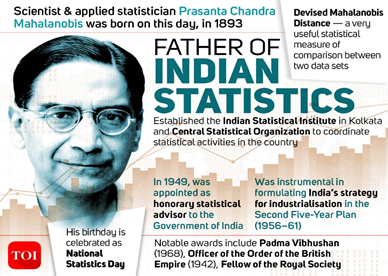

|
Overview
|
Context
June 29, is National Statistics Day, in recognition of the contributions made by Prof. P.C Mahalanobis, the ‘Plan Man’ of India.
- Given the emerging importance of ‘data’ in today’s world, it is important to analyse the status of ‘statistics’ in the country.
Background (Historical)
Before Independence (statistical thinking in ancient times)
- Mahabharata: In India, statistical knowledge and probabilistic ideas were attributed to the kings and rulers mentioned in the great Indian epic, the
- Mauryan period: During the Mauryan period, they had a detailed description of the system of data collection relating to agricultural, population and economic censuses in villages and towns during the period.
- Mughal period: The tradition of collecting data in detail continued during the period of Mughal emperor Akbar around 1590 A.D.
- The Ain-i-Akbari written by Abul Fazal during 1596-1597 A.D. has the best compilation of that period containing a wealth of information.
- This had details of several government departments including the system of legalized measurements, land classification and crop yields and other information.
- Abul Fazal was “regarded as a statistician”.
- British India: Later, it was developed during the British Raj. In the first phase, statistics were used for Famine data collection and for several data collection on land.
- The Ain-i-Akbari written by Abul Fazal during 1596-1597 A.D. has the best compilation of that period containing a wealth of information.
After Independence
- C Mahalanobis was appointed as honorary Statistical Adviser to the Indian Cabinet in 1949.
- A Central Statistical Unit was set up in the Cabinet Secretariat in 1949 under his technical guidance.
- A couple of years later the Central Statistical Organisation (CSO) were formed in 1951 to coordinate the statistical activities in independent India.
Analysis
Why statistics matter?
|
The meaning Statistics is a mathematical science involving the collection, analysis, and interpretation of data, as well as the effective communication and presentation of results relying on data. |
- Good governance: Statistics plays a key role in planning, monitoring and evaluation of socio-economic policies and improving governance.
- Better policy formulation: Local level statistics have immense significance for understanding the socio-economic reality and thereby appropriate policy formulation.
- Science: The concepts instatistics are the building blocks of the techniques and tools.
- Economic development: Statistics help identify needs, set goals, and monitor progress. Without good statistics, the development progress is blind: policy makers cannot learn from their mistakes, the public cannot hold them accountable.
- Other use
- evidence-based policy making
- planning, progress monitoring and evaluation of development activities
- global monitoring
- reliable, up to date and easily accessible database
|
Advantages of the statistics as a discipline |
Loopholes of statistics |
|
|
Assessing P.C Mahalanobis’s contributions towards Statistics
- As Initiator: Mahalanobis was introduced to the subject of statistics by his tutor, the Nobel Prize-winning physicist C.T.R. Wilson.
- In 1931, Mahalanobis founded Indian Statistical Institute (ISI), which was the first institute of its kind anywhere in the world devoted mainly to the study of statistics.
- He also established the National Sample Survey Office (NSSO) in 1950
- As explorer: The meeting of Mahalanobis and director of zoological survey resulted in the first paper (Mahalanobis, 1922) relating to the statistical analysis of Anglo-Indian stature.
- He continued to work on the anthropological data (Mahalanobis, 1925, 1930, 1931, 1936) and built up new methodologies for classifying or distinguishing populations characterized by such measurements.
- The famous Mahalonobis D2 emerged in course of this work.
- Mahalanobis was perhaps the first person to organise and carry out an objectively defined large scale survey covering the whole of Bengal (about 59000 square miles) in 1941.
- This scheme was designed to estimate the yield of jute crop and acreage under jute in Bengal.
- As Founder of discipline: At Mahalanobis's initiative, the first post graduate course in Statistics was introduced at Calcutta University in 1941.
- The first batch of students included R. Rao, who influenced the growth of the ISI more than anyone else except Mahalanobis and, along with Mahalanobis, is the most famous statistician to come out of the Indian subcontinent.

|
About National Sample Survey Office (NSO)
|
Future prospects of the discipline
- Career Opportunities: Statistics is listed among the Bureau of Labour Statistics’ fastest growing careers in 2018 and it’s predicted to grow 33 per cent by 2026.
- In modern Development: Statistics is indispensable in this modern age aptly termed as "the age of planning".
- Economic Development: Business executives are relying more and more on statistical techniques for studying the preference of the customers.


